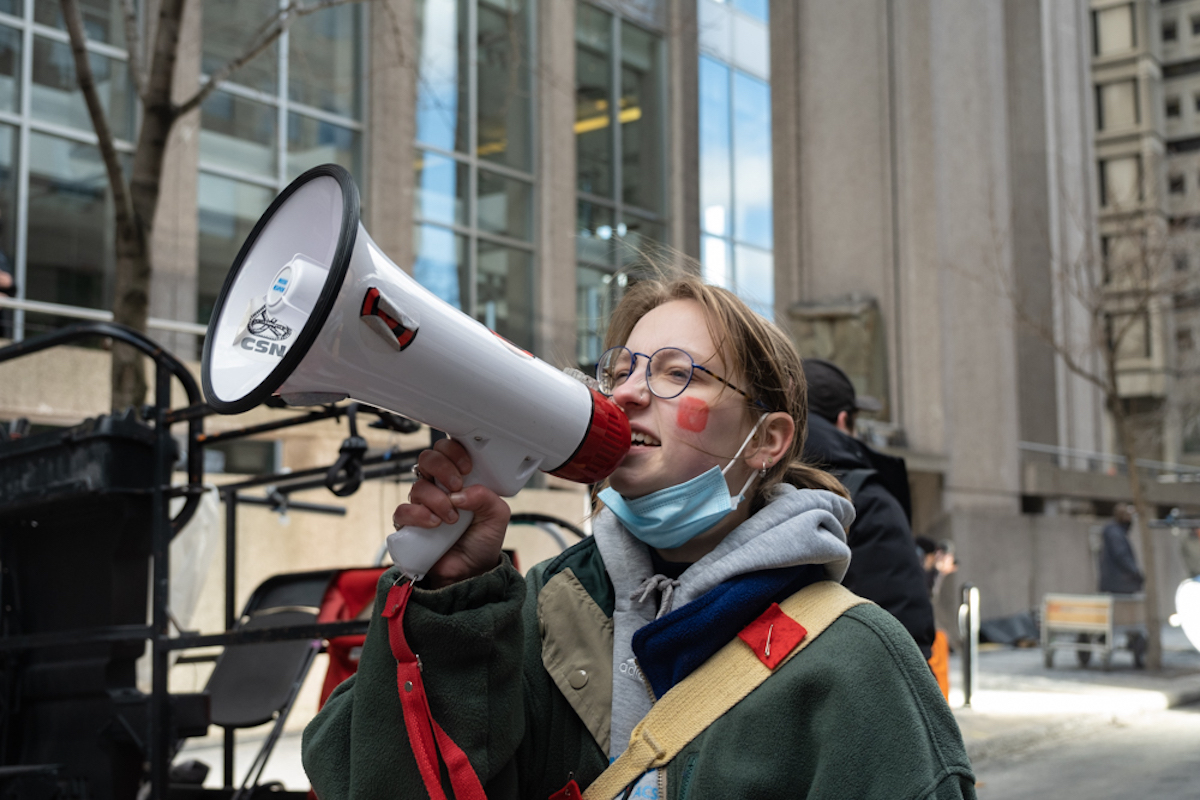Students and teachers protest against tuition hikes and demand free education at all levels
On Tuesday, March 22, hundreds of students gathered around Place du Canada to strike and mark the tenth anniversary of the 2012 Quebec strike against the provincial government and its increase in tuition fees. The demonstration was organized and led by several student associations across Quebec.
While others were marching and blocking the streets of Montreal, dozens of Concordia students set up tents on the second floor of the Hall building to show their support.
At the march, Ludmila Hérault, a 17-year-old student and spokesperson for Collège de Bois de Boulogne, addressed her speech to the government of Quebec.
“Dear government, aren’t you supposed to encourage a world in which every individual would have the same rights?” Hérault asked. “A world in which education is not about money, or a world in which each person is given the same opportunities in order to build the future they wish?” Hérault added.
According to Gratuité Scolaire, 85,000 students from 50 student associations in Quebec planned to go on strike that Tuesday.
Among the different students associations across Quebec demanding reduced fees was l’Association étudiante du Cégep de Sherbrooke (AÉCS) who travelled close to two hours to attend the protest.
“We came today [with] two buses from CEGEP Sherbrooke because we think that education is a right and not a privilege,” said Hugo Forget, a member of the AÉCS.
Since 2006, annual tuition for undergraduate students in Quebec has increased by $111 every year. Today, tuition for an undergraduate student reaches $4,310, compared to $2,506 in 2006. The Quebec government recently announced a 5.4 per cent increase in spending on education.
Many demonstrators marched wearing a red square of fabric to symbolize support for the 2012 student strike. The symbol has been used historically to represent students opposed to tuition increases and their supporters.
On March 18, 2011, the Quebec government, led by Jean Charest and the Quebec Liberal Party, announced a budget that hiked university tuition fees in what would amount to a 75 per cent increase from $2,168 to $3,793.
The decision to increase tuition fees sparked the longest student strike in history. From February 13, 2011, to September 7, 2012, student associations went on strike for an indefinite period before Bill 78 was passed, which forced students to go back to class and limited their right to protest.
At the strike on Tuesday, the Fédération nationale des enseigantes et enseignants du Québec (FNEEQ) walked alongside student associations in solidarity. Benoît Lacoursière, a member of the FNEEQ, was one of the many teachers present at the 2012 strike and was back to show his support.
“For us, it is a fundamental value to access education, and solidarity is a fundamental value,” said Lacoursière. “It is important to continue to maintain this current struggle.”
The main message of the recent protest was to give students a voice and hope for their future education. Speakers also called attention to unpaid internships and demanded free education at all levels.
“We are on their side not only in class, but outside in their demands, and then it is their turn to speak,” said Martine Huot, a professor at Cégep du Vieux Montréal.
Following Concordia’s School of Community and Public Affairs Students’ Association (SCPASA) assembly on March 16, many members of the SCPASA joined the free education strike.
“Today is about showing the students are capable of mobilizing and creating momentum for future movements,” said Joshua Sallos, a member of the SCPASA.
At Concordia University, the students who set up tents on the second floor of the Hall building to occupy the space requested to be referred to by their first names to demonstrate a group effort.
“We’ve been a group of non-hierarchical students who are looking to democratize education, to exercise our power and our right as students to demand change and to organize as students to kind of force that change upon institutions, rather than just as individuals trying to approach an institution with issues,” said Luna, a participant.
Though the occupation was a joint effort among students, a source clarified both Arts and Science Federation of Associations (ASFA) and Concordia Student Union (CSU) helped fund and provide food for the protest.
The group camped for three days and held general assemblies every night at 7 p.m. to discuss their demands about free education.
“We were trying to keep it under wraps. […] It was mostly affinity-based,” said Errico, one of the group’s security liaisons.
On Tuesday night, students shared their demands, writing them on a whiteboard. A few requests included free education, commitment to divest, more voices in student government, disability justice, non-corporate education, better engagement from faculty, and more.
On Wednesday morning, Andrew Woodall, dean of students, was on-site to speak to the occupiers.
“My role is to develop relationships with the students, understand what they are doing and make sure that they have someone to whom they can reach out if there are any problems or concerns about logistics or anything else,” said Woodall.
The occupation ended on Friday following a teach-in rally where Indigenous leaders and activists spoke about the climate crisis at the Sir George-Étienne Cartier Monument in Mount Royal Park.
Photos by Kaitlynn Rodney and Catherine Reynolds
